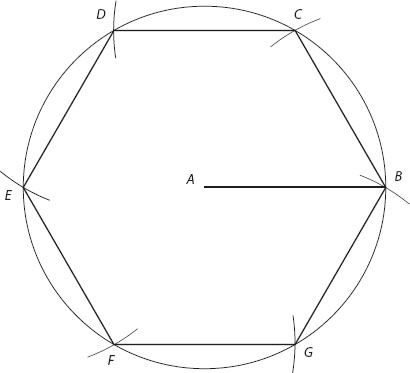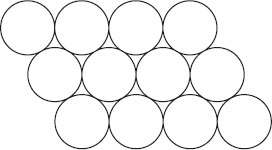Hexagons
A regular polygon is a convex polygon whose sides all have the same length and meet each other at the same angle. Next to the equilateral triangle, the simplest regular polygon to construct—using only the Euclidean tools—is the six-sided hexagon. Let the side ![]() be given (figure 19.1). Draw a circle with center at A and radius
be given (figure 19.1). Draw a circle with center at A and radius ![]() , place the point of your compass at B, and without changing the compass’s opening, swing an arc, cutting the circle at C. Now place your compass at C and, with the opening still the same, swing a second arc, cutting the circle at D. Repeat the process three more times, resulting in points E, F, and G (if you do it one more time, the last point should coincide with B—provided, of course, that your drawing was exact). With a straightedge, connect pairs of adjacent points and you get a perfect hexagon, with its high degree of symmetry (six 60° rotations and six reflections).
, place the point of your compass at B, and without changing the compass’s opening, swing an arc, cutting the circle at C. Now place your compass at C and, with the opening still the same, swing a second arc, cutting the circle at D. Repeat the process three more times, resulting in points E, F, and G (if you do it one more time, the last point should coincide with B—provided, of course, that your drawing was exact). With a straightedge, connect pairs of adjacent points and you get a perfect hexagon, with its high degree of symmetry (six 60° rotations and six reflections).
The hexagon is one of only three regular polygons that can tile, or tessellate the plane—fill it completely without gaps or overlaps. The other two are the square and the equilateral triangle; but since a hexagon can be dissected into six equilateral triangles, the hexagonal and triangular tessellations are not really different. Hexagonal tiling, while not as common as square tiling, can be seen at many places; a good example is the paving of the subway stations of Washington, DC.

Figure 19.1
Suppose you want to place rows of identical coins on a table so that each coin touches its immediate neighbors. This can be done in two ways: either the coins in successive rows are placed above one another, so that each coin is surrounded by eight neighbors whose centers form a square (figure 19.2); or else each row is offset with respect to the row below it, the coins in the second row partially filling the space between those of the first row (figure 19.3). In this second arrangement, every coin is surrounded by six neighbors, whose centers form a hexagon. The resulting array is not only more stable but also more efficient—it packs more coins per unit area.

Figure 19.3
The analogous configuration in three dimensions, with spheres replacing the coins, has puzzled mathematicians for more than three hundred years. The great German astronomer Johannes Kepler (1571–1630) conjectured in 1611 that this arrangement represents the most efficient packing of identical spheres, resulting in a density of ![]() spheres per unit volume, or slightly more than 74 percent. Amazingly, his conjecture—well known to any fruit vendor who packs a pile of oranges in a box—remained unproved until 1998, when the American mathematician Thomas Hales used a computer program to exhaust the large number of possible cases.
spheres per unit volume, or slightly more than 74 percent. Amazingly, his conjecture—well known to any fruit vendor who packs a pile of oranges in a box—remained unproved until 1998, when the American mathematician Thomas Hales used a computer program to exhaust the large number of possible cases.
The hexagon was known to humans for thousands of years, as evidenced by the six-spiked wheels of Babylonian and Egyptian chariots. Nature, too, takes advantage of the hexagon’s high degree of symmetry. Snowflakes, with their infinite variety of fine structure, invariably crystallize into perfect hexagons, a fact that never fails to fascinate nature lovers. And then there is the honeycomb, whose occupants, the hardworking honeybees, diligently shape their wax-made habitat into hexagonal prisms, making this shape a fitting logo on honey products.
Plate 19, Parquet, seems at first to show a stack of identical cubes, arranged so that each layer is offset with respect to the one below it, forming the illusion of an infinite, three-dimensional staircase structure. But if you look carefully at the cubes, you will notice that each corner is the center of a regular hexagon. I still remember my amazement when, as a physics student, I first noticed this sixfold symmetry in an object that at first thought should only have two- and fourfold symmetries. It takes a while for the eye to recognize this, as the entire array seems to jump in and out of space, at one moment appearing as if the cubes point straight at you, only to reverse their orientation at the next. An optical illusion? A trick that the brain plays with our eyes? I let the reader decide.


